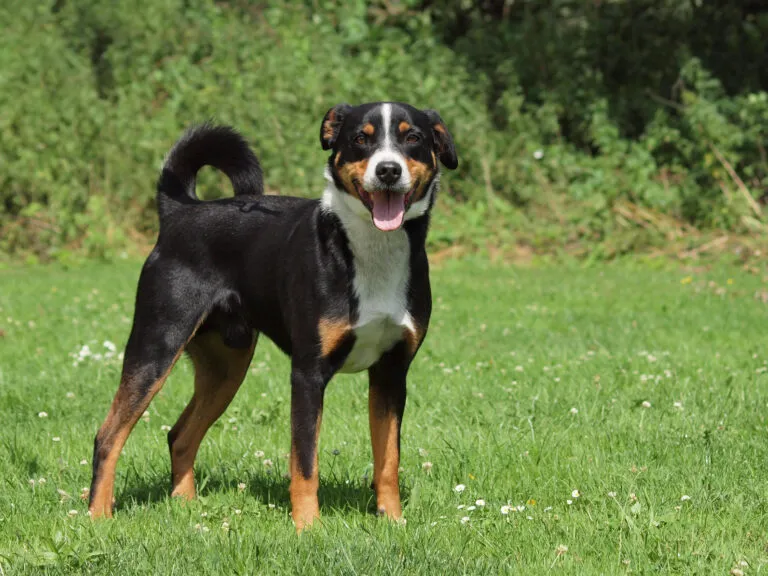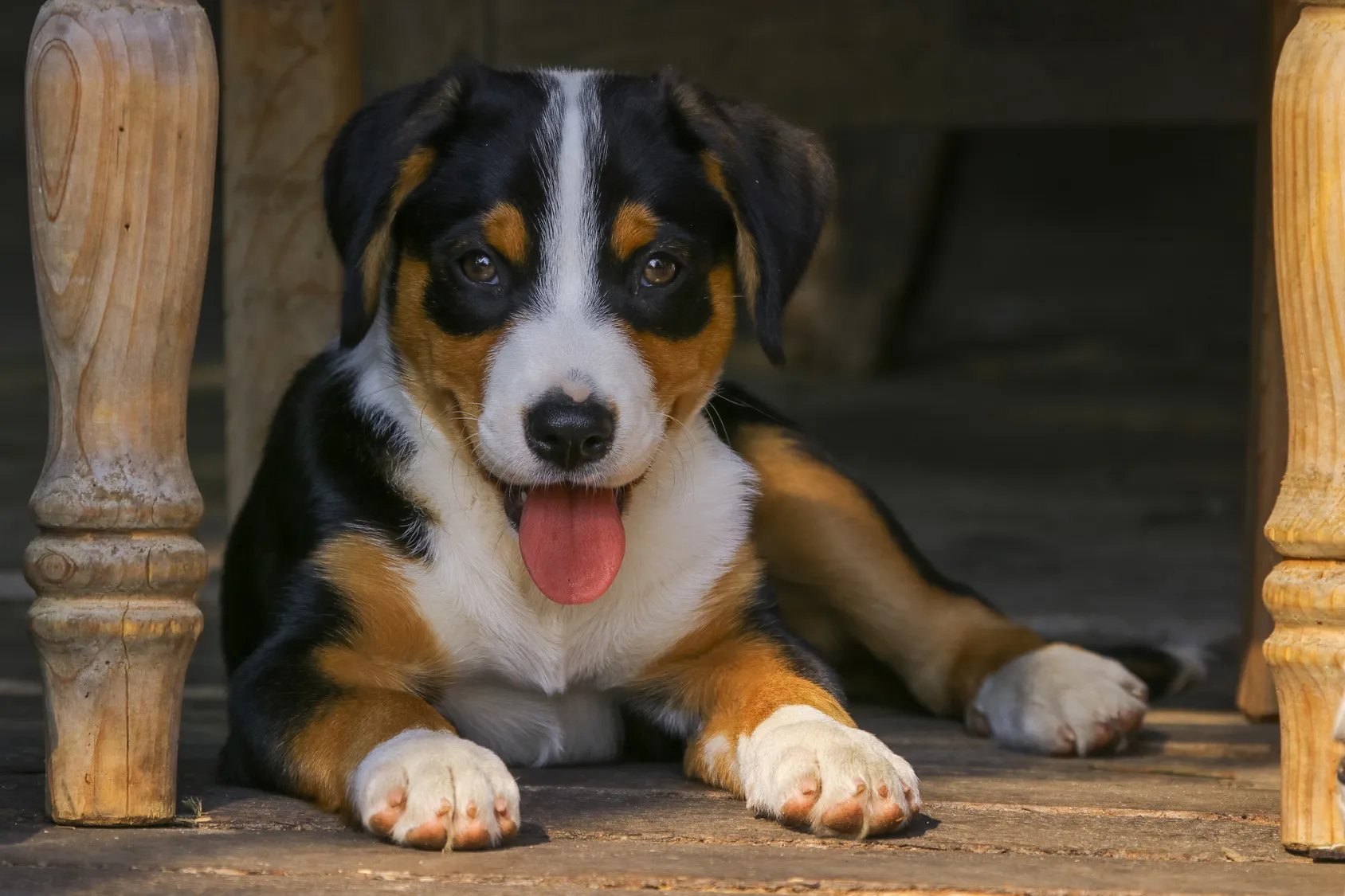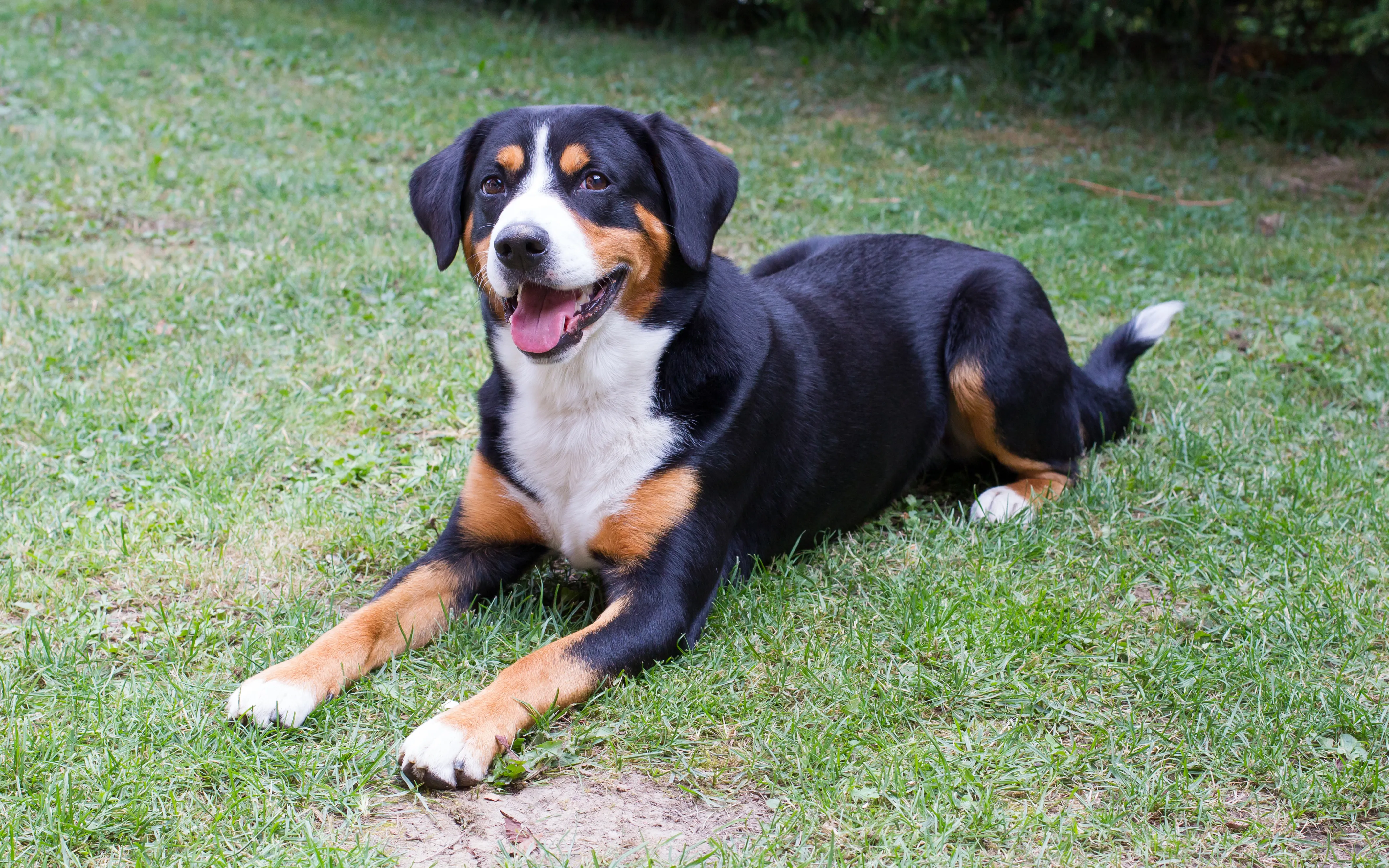Beagle
The Beagle's short legs can be deceiving – this medium-sized dog keeps you on your toes and is always full of surprises! This friendly breed is active, fearless and extremely clever.
The Appenzeller Mountain Dog isn't a good fit for couch potatoes. Bred as a farm and herding dog, this pedigree dog from the canton of Appenzell is a bundle of energy. With a sporty owner offering sufficient exercise, this loud, nature-loving dog can feel at ease as a family dog.

© michaklootwijk / stock.adobe.com
Rounding up a herd of 200 animals across a wide terrain is no problem for these herding dogs. They are nimble, have great stamina and are happiest when constantly moving around. Putting their feet up and lazing around just doesn’t cut it for Appenzeller Mountain Dogs. Originally bred as pedigree utility dogs for Swiss farmers and shepherds, they innately possess a striking enthusiasm for their work. Their urge to keep occupied, endurance and willingness to learn make them predestined not just for herding, but serving as guide dogs, medical service or avalanche dogs. In addition, their unerring protective instinct, loyalty and courage make them valued watch and guard dogs. These attentive observers are reliable guardians, and are more than happy to communicate their vigilance by barking loudly. It’s quite clear that the Appenzeller Mountain Dog is no shrinking violet.
Typically loud barking is a characteristic of the breed, be it when on guard, playing or to show love and enthusiasm. However, consistent training can reduce this barking to a manageable level. After all, Appenzeller Mountain Dogs are very obedient and willing to learn. They are loyal to their owners and always reliably complete tasks assigned to them. Equally, they are intelligent and have special observation skills. Highly empathetic, they assess their caregiver’s gestures and facial expressions in a flash and react accordingly. Despite their temperament, they are very sociable and maintain a particularly close relationship with their owner, but are highly convivial and cheerful in contact with other family members too. These lively dogs love playing with children, but sometimes puppies can nip their playmates due to high spirits and the sheer love of play. Whilst this is intended in a purely friendly manner, it is still undesirable.
With the right mix of love and consistency, living with an Appenzeller Mountain Dog is generally harmonious and unproblematic. These Swiss pedigree dogs are tolerant of other animals in the home. They initially regard strangers with certain mistrust, but don’t act in an aggressive or enraged manner. At the same time, they wouldn’t hesitate to defend their loved ones if danger were truly afoot. The Appenzeller Mountain Dog is therefore an ideal companion for sporty families who value its unerring vigilance and loyalty.
 © Lars Gieger / stock.adobe.com
© Lars Gieger / stock.adobe.com
This pedigree dog’s self-assured nature and lively temperament is evident upon the very first glance. Its nimble movements and shrewd facial expression quickly reveal who you’re dealing with. When the sheer power of its bark breaks out, it can be sure to have gained the respect of its counterpart.
This medium-sized, almost square-shaped dog is in every respect well proportioned. Its muscular and mobile body is up to 52 to 58cm in height for males, whilst bitches are only slightly smaller at 50 to 54cm. It weights from 25 to 32kg, although this is not outlined in the breed standard. The head is slightly wedge-shaped with a flat forehead and slightly pronounced stop. The triangular ears are highly set and lie flat when idle. When paying attention, they are raised at the base and form a triangle with the head. The small almond-shaped eyes are dark to light brown in colour and are set at a slight slant. The wide and deep chest is positioned underneath the short but powerful throat with a prominent fore-chest. A defining characteristic is the densely haired and curly tail, which is often described as a “post horn” tail.
The colour of the fur is symmetric, just like the physique. The base colour of the guard hair is black, with white and reddish brown markings. A striking white blaze extends from the top of the head to the snout and from chin to chest. The paws and tip of the tail are white. Along with typical black, Havana brown is allowed as a base colour. The short and tight guard hair is shiny and along with the luxuriant undercoat reliably protects this herding dog from the Swiss Alps from wind, rain and cold.
The nature and appearance of the Appenzeller Mountain Dog are perfectly adapted to the conditions of its region of origin. They originate from the Swiss Alps and developed into perfect cattle herders together with the farm economy. Although the exact origin of the breed is unknown, we can take a guess that its ancestors were the dogs of war that accompanied the Romans when they crossed the Alps. The first breeders were farmers from the canton of Appenzell who kept and bred the dogs predominantly due to their utility.
To this day, Appenzeller Mountain Dogs are successfully deployed as both herding dogs and guard dogs on farms. Their versatility as utility dogs was first described in “Tierleben der Alpenwelt” (“Animal Life in the Alps”) in 1853. The Swiss forester Max Sieber was the first patron of the breed, presenting the first breed characteristics for the Appenzeller Mountain Dog to the Swiss Kennel Club (Schweizerische Kynologische Gesellschaft, SKG) at the end of the 19th century. In 1898, eight Appenzeller Mountain Dogs were first introduced in the new class “Mountain Dogs” at an international canine exhibition. The first breed club was founded in 1906 at the suggestion of Professor Albert Heim, a geologist and cynologist who was very dedicated to Swiss mountain dogs. The club advanced targeted pedigree breeding and thereby maintained and promoted the breed in its natural state. In 1914, Heim established the first valid breed standard.
Nowadays the Appenzeller Mountain Dog is an independent breed recognised by the FCI. The Fédération Cynologique Internationale lists the breed under number 46 in group 2, “Pinscher and Schnauzer, Molossoid and Swiss Mountain Dogs”, section 3 “Swiss Mountain Dogs”. The Appenzeller forms part of the Swiss mountain dog group together with the Greater Swiss Mountain Dog and the Bernese and Entelbucher Mountain Dogs. Unlike the Bernese Mountain Dog, the Appenzeller is still quite a rare breed with a comparatively small breeding base. Although fans of the breed can be found not just in Switzerland but in Germany, Austria, Finland, the Czech Republic and other countries too, the Appenzeller breed is considered to be at risk of extinction. Having taken on the task of protecting the biodiversity of rare plants and animals and maintaining their natural state, the Swiss foundation ProSpecieRara has accepted the Appenzeller Mountain Dog.
The Appenzeller Mountain Dog’s very small breeding base and the manageable number of suitable breeding animals demand that breeding be carried out in a very careful and responsible manner to avoid hereditary diseases typical of the Appenzeller. Serious and responsible breeders aren’t concerned with getting their hands on as many puppies as possible and selling them to the highest bidder. On the contrary, health and maintaining the excellent genes of this pedigree breed are the priority. Comprehensive tests on the parent animals and puppies and strict breeding guidelines reduce the risk of diseases.
The most common breed-specific illnesses are joint problems (hip dysplasia [HD], elbow dysplasia and osteochondrosis), ocular diseases (cataracts), heart failure and skin problems such as tumours with the onset of old age. It’s evident that numerous tests for these diseases cost the breeder an awful lot of money. Along with the expenses for membership of a breed association, licensing, mating the female, travel costs, food, vet bills, microchips and much more, the sale price doesn’t always cover the costs or only just does so. You should expect a price of at least 1,000 to 1,200 euros for a healthy, well cared-for puppy that has received all its vaccinations and several deworming treatments. However, this price should be more than worthwhile for a healthy dog with a life expectancy of 15 years.
 © michaklootwijk / stock.adobe.com
© michaklootwijk / stock.adobe.com
Of course the health of the Appenzeller Mountain Dog doesn’t depend solely on the breeder, but rather starts here; maintaining good health is the responsibility of the subsequent owner. With healthy puppies, an annual check-up at the vet where required injections are performed and boosted is more than sufficient. Nutrition is the main factor that determines whether your dog will remain slender, active and eager to move around.
In relation to its size, an Appenzeller Mountain Dog requires a very small amount of food. Food that is too abundant or energy-rich leads to obesity and can have grave consequences for dogs that are still growing. Inappropriate protein, mineral and vitamin intake can lead to accelerated growth that in turn brings on joint or muscle problems and diseases affecting the internal organs. Along with a lack of desire for activity, an indication of obesity is when the rib pairs and hip bones can no longer easily be felt. Small portions of a high-quality food slow down the growth rate and thereby have a positive impact on the bones, muscles and organs.
This doesn’t mean you should let your dog go hungry, because active Appenzellers of course require sufficient provision. The diet should cover the daily energy requirements and provide them with necessary nutrients, minerals and vitamins. Along with the required energy and protein content, the food’s calcium, phosphorous and vitamin D3 content should be considered. Ask your breeder or vet for a comprehensive diet plan and tips on the most suitable food for your Appenzeller.
Lots of activity is essential for your Appenzeller Mountain Dog to avoid obesity. As working dogs, which can energetically and nimbly round up a huge number of sheep or cows across a wide area, they require a great deal of exercise and activity. They are certainly no dogs for couch potatoes! On the contrary, their lively and tenacious temperament demands a sporty owner willing to undertake more than a daily walk. Dog sports such as agility are ideal as a replacement activity for herding. Equally, running alongside during a bike ride or dog trekking (long hikes with dogs) will be just as much fun for the Appenzeller.
In comparison to the requirements for exercise, grooming the Appenzeller takes no time at all. It’s more than sufficient to occasionally brush the short guard hair.
If your dog is utilising its full mental and physical capacities, training this eager-to-learn breed is very easy. Thanks to its great empathy, quick comprehension and willing-to-learn nature, training success comes quickly with the Appenzeller Mountain Dog. However, like all dogs it requires certain consistency and rigour in its training. To moderate its innate love of barking at an early stage, your commands should be clear and regularly repeated. Attending a dog school is well worthwhile in many cases. The most important things though for human and dog to live together harmoniously are patience and mutual trust and love.
The Beagle's short legs can be deceiving – this medium-sized dog keeps you on your toes and is always full of surprises! This friendly breed is active, fearless and extremely clever.
The Golden Retriever is still one of the most popular dog breeds, especially with families. It is defined not just by its docility, but shows numerous other qualities too. Read in the following article everything you need to know about the Golden Retriever.
The German Shepherd is one of the most popular utility dog breeds in the world, though the willing-to-learn and people-focused nature of these versatile dogs also makes them suitable for family life.